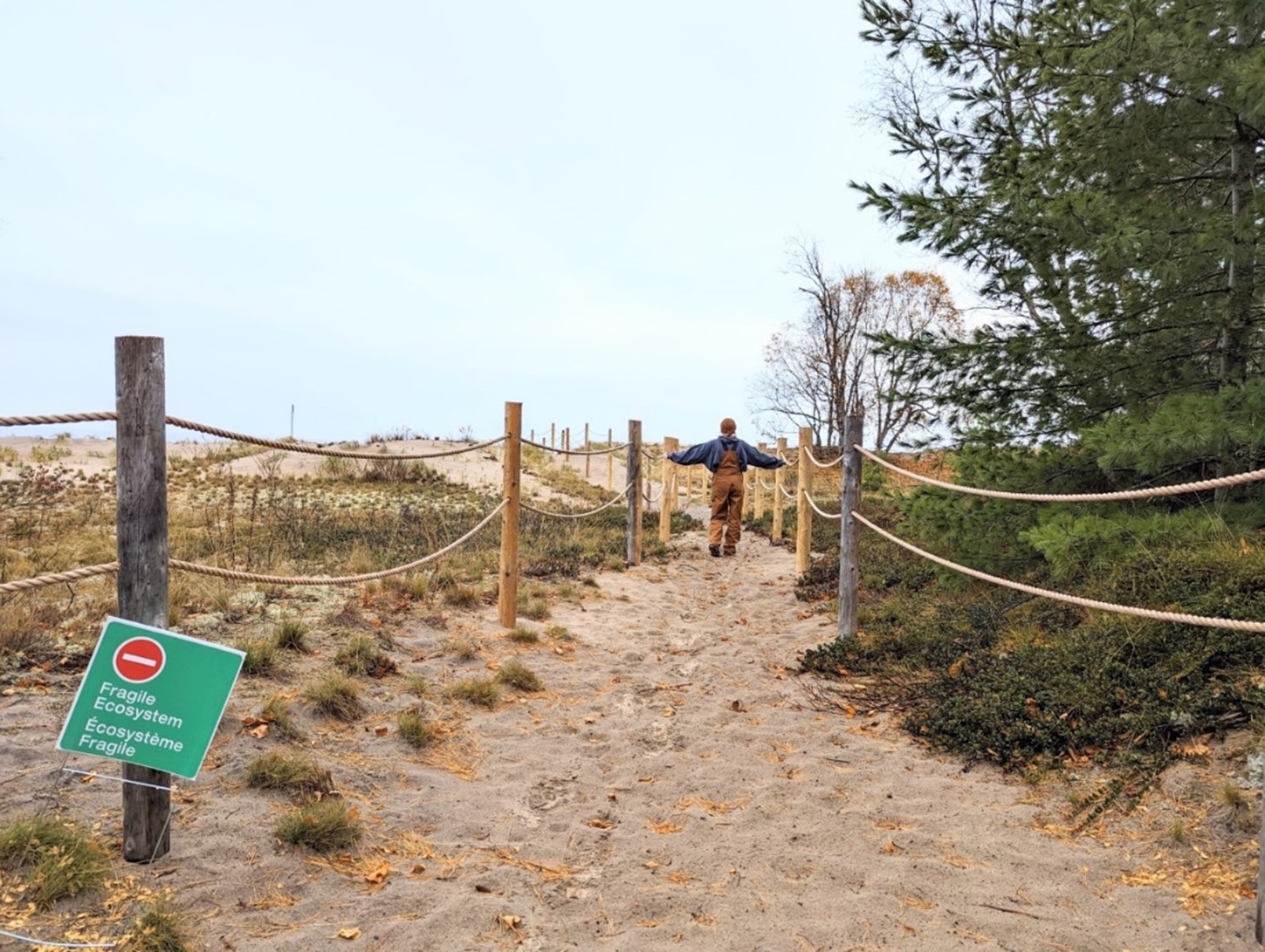Today’s post comes from Mikhaila Lafleur-Weidhaas, a park warden at Pancake Bay Provincial Park.
Two beach trails diverged at a dune, one well-travelled and clear — the other a shortcut. Do you take “the road most travelled?”
The coastal shores of Lake Superior, with its sand beaches and Caribbean blue water, have been a popular attraction to thousands, from nomadic voyagers to people looking for paradise close to home.
However, as people run to Ontario’s beaches looking for a staycation, more pressure is being placed on our sandy shores.
This increased pressure can cause a decline of these dynamic and rare freshwater coastal dune ecosystems.
Development of a dynamic dune
A dune is a complex system that is always in motion, caused by the wind and water changing the shape of the coast seasonally.
As the elements move the sand, obstacles such as driftwood become integral to the dune’s development.
The sand travels over the driftwood and is deposited on the other side of the windbreak, slowly collecting until a mound is created and the original log is buried in the dune.
This is the beginning of an “embryo” dune, the first step of many in its development.
As seasons pass the dune becomes larger, more established, and can be colonized by pioneer species such as Marram Grass (also known as American Beach Grass).

Marram Grass is the most important beach plant, with its 1-metre-deep tap root, large mat of underground stems, and delicate root system. This complex underground system holds the grains of sand in place, keeping the integrity of the dune in high-water years, decreasing the effect of erosion on the beach.
Essentially, no dune grass means no dunes.
And if there are no dunes, there is no beach.
Finding rare Ontario wildlife
Once the Marram Grass establishes and the dunes further develop, rare and specialized wildlife and plants begin to migrate to the area.
Rare plants such as Woolly Beach-heather can grow. Birds and small mammals have a place to nest and reproduce.

In fact, the beach at Pancake Bay is one of only about a dozen locations in Ontario where you can find the Threatened Lake Huron Grasshopper (Trimerotropis huroniana).
This species is only found on dune ecosystems along the shores of Lake Huron, Lake Michigan, and Lake Superior; and Pancake Bay is the only known location on the Ontario shore of Lake Superior.

They are tough creatures, occupying the sparsely-vegetated beach or lakeside face of a dune where they are most exposed to the elements.
Their diet is mainly Marram Grass and Sage Wormwood. As you can see in the above photo, they are well camouflaged and would be difficult to spot.
An ecosystem in peril
The Great Lakes dunes are in danger of irreversible damage.
Dune ecosystems in Ontario consist of less than 0.5% of the total ecosystems found in the province and Pancake Bay is privileged to protect over 3 km of dunes and beach.
Pancake Bay has observed record visitor attendance during the past several seasons, leading to an increase in the number of shortcuts created as people walk to their favorite beach spot.
Increased foot traffic on the dunes and the trampling of the Marram Grass can cause catastrophic damage to their roots.
The additional stress on the dunes caused a loss of the dunes at unprecedented rates as the shortcuts become more utilized instead of the main access points.
Fortunately, it is not too late to reverse the damage and save the dunes and the beach.
A simple solution to a complex problem
Pancake Bay is implementing a restoration plan to help visitors find the best beach access points while providing relief to impacted dunes.
This project can be summed up into three parts, the first being the installation of a beautiful cedar fence with ropes to guide visitors to the main access points while avoiding fragile ecosystem areas.
Park staff dug 1 m deep holes in the sand using a shop vac, which is less invasive on the direct environment as smaller holes could be made for the cedar posts.
The poles were placed every 3 m, then cut to 1.4 m tall. Once trimmed, two holes were then drilled creating a roped-off area without affecting the aesthetic view.
This fencing type allows visitors to appreciate and interact with the environment around them while minimizing the effects of human activity on protected areas.
The second step is the transplanting and planting of Marram Grass on the running dunes and along the productive edges of the dune.
Marram Grasses are carefully removed from a local donating dune, transplanted in impacted areas, then snow-fenced for additional protection and sand collection over winter.
Locally grown conifers are transplanted at the entry to the many shortcuts into the dune creating a natural physical barrier.
The final step is to allow our best tool, natural regeneration, to proceed.
Please do your part
If we stop interrupting the natural process of dune formation, we will have more beach to enjoy year after year.
Dunes are highly dynamic ecosystems and staff are hoping to see a positive change within the first year. However, this cannot be accomplished without the help of campers.
Remember: taking the right path to the beach ensures your enjoyment of the beach for years to come.






